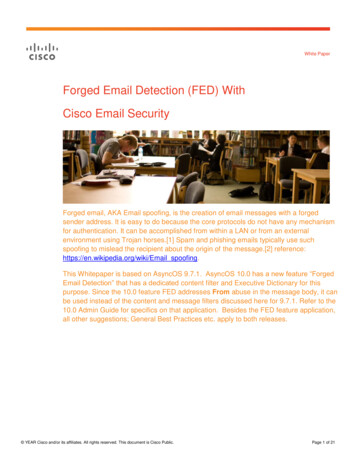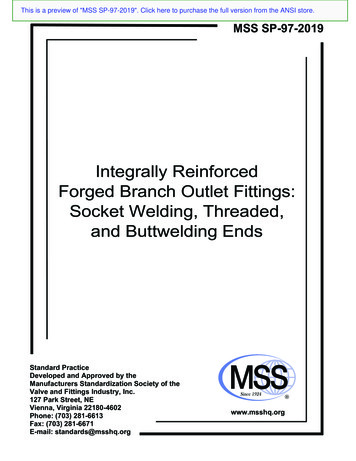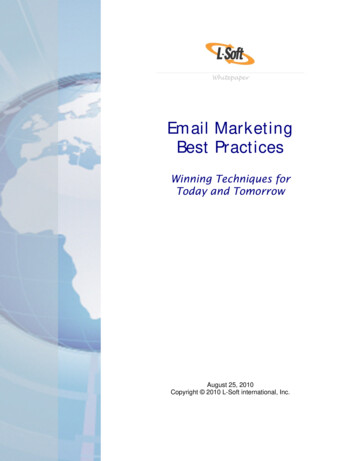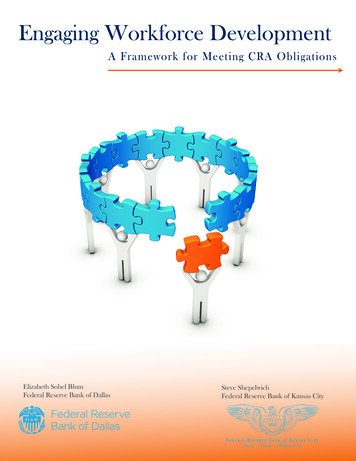
Transcription
White PaperForged Email Detection (FED) WithCisco Email SecurityForged email, AKA Email spoofing, is the creation of email messages with a forgedsender address. It is easy to do because the core protocols do not have any mechanismfor authentication. It can be accomplished from within a LAN or from an externalenvironment using Trojan horses.[1] Spam and phishing emails typically use suchspoofing to mislead the recipient about the origin of the message.[2] reference:https://en.wikipedia.org/wiki/Email spoofing.This Whitepaper is based on AsyncOS 9.7.1. AsyncOS 10.0 has a new feature “ForgedEmail Detection” that has a dedicated content filter and Executive Dictionary for thispurpose. Since the 10.0 feature FED addresses From abuse in the message body, it canbe used instead of the content and message filters discussed here for 9.7.1. Refer to the10.0 Admin Guide for specifics on that application. Besides the FED feature application,all other suggestions; General Best Practices etc. apply to both releases. YEAR Cisco and/or its affiliates. All rights reserved. This document is Cisco Public.Page 1 of 21
Table of ContentsForged Email Problem . 3Anatomy of a Forged Email and its SMTP Details . 4Forged Email Detection Workflow . 5Forged Email Decision Tree . 6General Best Practices to Prevent Spoofing . 7Host Access Table Modification to Prevent Spoofing . 7Forged Mail Resolution . 8Monitor . 8Warn . 9Enforce . 10Addressing Envelope From Abuse . 10Verifying Remediation of Envelope From Abuse . 10Addressing From Header Abuse . 12From Header Abuse Remediated . 13Addressing Cousin Domain Abuse . 15Remediating Cousin Domain Abuse . 16Free Email Account Abuse . 17Remediation of Free Email Account Abuse . 18Comprehensive Configuration for all Listed Spoofing Types . 19Next Steps . 20 YEAR Cisco and/or its affiliates. All rights reserved. This document is Cisco Public.TOCPage 2 of 21
Forged Email ProblemThis paper focuses on the resolution of spoofs from outside an organization where the senders areimpersonating employees inside the organization. Their purpose is to deceive employees in order to stealmoney or information. We will discuss four different variants of this attack, and propose solutions for thisusing Cisco’s Email Security Solution running AsyncOS 9.7.1. Addressing circumstances of spoofingwhere an internal mailbox is compromised is out of scope for this paper. For an introduction to spoofingrefer to: fing-and-how-to-detect-it. In all examples in thisdocument, alpha.com is the example customer domain being spoofed.Briefly described, spoofing attacks include:1. Envelope From Abuse: Making the domain in sender’s mail From value, also referred as"Envelope From” the same as the recipient domain: (This paper uses these terms interchangeably)2. From Header Abuse: Using a legitimate domain for the sender’s envelope from value but afraudulent From Header3. Cousin Domain Abuse: Sending from cousin domains that pass SPF, DKIM and DMARC checks.The From value will show a legitimate sender address ie: alice@a1pha.com to impersonatealice@alpha.com4. Free Email Account Abuse: Using free email (yahoo, gmail etc) that pass SPF, DKIM and DMARCchecks. The From header will show a legitimate sender address with an executivesname@gmail.comThe four variants of attacks described above, are shown below in the mailbox alan@alpha.com. Thevariants are listed from top down in the same order described earlier, along with a legitimate healthcaremailer in Figure 1. Each fraud lists an executives name in the From field. Figure 2 shows the details of anattack similar to the first variant in Figure 1. Our goal is to block any spoofs in these categories, but allowlegitimate mailers, like the one sending the healthcare notice, to be delivered.Figure 1.Forged Mail Attacks on mailbox alan@alpha.comEnvelope From AbuseFrom Header AbuseCousin Domain AbuseFree Email Account Abuse YEAR Cisco and/or its affiliates. All rights reserved. This document is Cisco Public.TOCPage 3 of 21
Anatomy of a Forged Email and its SMTP DetailsThe structure of the message in Figure 2 is very similar to our first variant in Figure 1. Both are examplesof “Envelope From Abuse. The Envelope From field, shown below in the SMTP connection, is illegallyusing the domain name alpha.com. Envelope From abuse is easily remediated with Sender Verification,discussed later. But the problem is that Sender Verification only checks the SMTP Envelope portionshown in Figure 2. The harder to detect spoofs introduced earlier: From abuse, Cousin Domain abuse andFree email account abuse all have legal SMTP Envelope portions, but their Body portions of the message,see Figure 2, are designed to deceive the recipient. These two portions do not have to agree. In fact thereare legitimate external mailing lists in which they may not.Figure 2.SMTP Envelope and Body of “Envelope From Abuse”. YEAR Cisco and/or its affiliates. All rights reserved. This document is Cisco Public.TOCPage 4 of 21
Forged Email Detection WorkflowThe default settings of Cisco Email Security will prevent broad-based attacks, such as malicious files andsnowshoe spam. However spoofing, like other targeted attacks, is tailored for a specific organization. Forthat reason, preventative tools for spoofing attacks are disabled as their application may vary from oneorganization to another, and their improper application can lead to a high incidence of false positives. TheFED workflow in Figure 3 is a high level view for remediating spoofing attacks on your organization. Wewill provide details on each step. The final result is a defense in depth approach to Forged EmailDetection. Since a targeted attacker will change their methods against an organization over time, theadministrator needs to monitor this change and follow up with appropriate warnings and enforcements.Figure 3.FED WorkflowThe elements that address “Best Practice settings”, and filters that monitor, warn and enforce againstspoofing attacks are shown below in Figure 4. The Monitor should quarantine copies of all possible spoofs,illegitimate as well as legitimate mailers for one week and then delete. The admin must update theEnforce filter based on what it missed, but was caught by Monitor or by a recipient. We will reference thisdiagram throughout this whitepaper.Figure 4.Cisco Email Security Pipeline YEAR Cisco and/or its affiliates. All rights reserved. This document is Cisco Public.TOCPage 5 of 21
Forged Email Detection Decision TreeThe decision tree in Figure 5 is structured to detect and remediate any of the four spoofs shown in Figure1. Sender Verification in decision blocks 2 and 3 are redundant to the condition: “No Envelope from matchon recipient domain” in blocks 5 and 6. If your filters follow this design, then use either one or the other.Dropping mail from violations at the SMTP connection assumes that you have no need to analyze themessage content for a False Positive. Our Monitor Filter conditions in decision block 5 have a broaderrange of matches than the Enforce Filter in block 6 due the use of OR and AND logic. Your filter logic maybe different than these, but you should follow the same approach: monitor liberally but enforceconservatively. The Enforce filter is a message filter that sets an X-header before policies are applieddownstream. This allows us to take action in decision block 7 with those policies by applying content filterswithin them. For example a message that is tagged with a spoof X-header needs to be handled differentlywhen the recipient is an executive verses a standard employee. This whitepaper will look at these blocksindividually by demonstrating how they remediate the specific spoofs discussed at the beginning. At theconclusion we will combine all of these together in a solution described by this decision tree. For thereader, it is a good plan to make a similar decision tree for your email solution before you begin to applyyour anti-spoofing polices.Figure 5.Decision Tree YEAR Cisco and/or its affiliates. All rights reserved. This document is Cisco Public.TOCPage 6 of 21
General Best Practices to Prevent SpoofingBefore configuring specific filters, recognize that our spoof samples are corner case attacks on Alpha Inc.Many spoofs are remediated by exercising best practices. Referencing the pipeline in Figure 4, these are: Limit the use of Whitelisted domains in the Host Access Table (HAT) to a very few core businesspartners. Track and update members in your SPOOF ALLOW sender group (HAT), if you have one. Track and Update Allowed Senders in your SPF records, if you publish them. Drop Positively Identified spam Enable Gray Mail Detection and flag or place instances in the Spam Quarantine Enable URL Filtering to give maximum visibility into URL-based threats Enable Message Modification in Outbreak Filters to rewrite Suspicious and Malicious URLs Publish your companies DKIM, SPF and DMARC records Enable DMARC verification Modify your Host Access Table (to address spoofing, see below)Details on these best practices are available 1732910.html.Note:Publishing DNS TXT records for sender authentication allows for greater efficacy in fraud detection thanmaintaining dictionaries alone. However, methods of publishing these are beyond the scope of this whitepaper.Host Access Table Modification to Prevent SpoofingReference decision blocks 2, 3 and 4 in Figure 5. Incoming messages that fail a DNS check OR do nothave any SBRS scores will drop to the UNKNOWNLIST. To avoid that for spoof Envelope From Abuse,here we’ve segmented off part of the UNKNOWNLIST SBRS range for a CAUTION LIST below in Figure5. Lists numbered 4 and 5 have “Include SBRS Scores of None" for 4 and “Connecting Host DNSVerification” for 5 enabled. This allows you to specialize the Mail Flow Policies for messages that fail thesechecks. You may be introducing delays for some legitimate messages. Not shown here, would be anALLOWED SPOOFERs list for legitimate mailers that can send into your organization.Figure 6.Modified Host Access Table to Address Forged MailManual telnet of the SMTP connection can accidentally break syntax rules in RFC 2821. You can catchthese with “Strict” Address Parsing on the Listener, see decision block 1 Figure 5. This will catch some, butthe sophisticated attackers won’t be dissuaded by this. YEAR Cisco and/or its affiliates. All rights reserved. This document is Cisco Public.TOCPage 7 of 21
Forged Mail ResolutionIt is not typical for a Cisco customer to encounter all of these spoofing variants described in the ProblemSection, but many are plagued by at least one. As a case study, we will be treating this multi-variant attackon the alpha.com domain for framing our suggested solutions. They come from Cisco Email Securityexperts with real world experience who have been working to protect customers from these attacks. Theseare suggestions rather than fixed antidotes for particular problems. The examples and solutions presentedare provided as guidelines to assist with remediating these abusive messages. Implement these solutionsin an ongoing process of: Monitor, Warn and Enforce.MonitorYou need to monitor all inbound spoofing traffic, legitimate and illegitimate. For that, identify domainnames that should not be values in the envelope from or From headers and make them members of adictionary, as we’ve done in Figure 4 with “No Spoof Domains”. Create a filter to make a copy of everyemail where the MAIL FROM or the From header matches domains in the dictionary into a “Spoofs”Quarantine, with a reasonable Delete on Expire policy (possibly 7 days). This gives you visibility into whatis being spoofed. Also consider spoofing from legitimate mailer services that are abused by illegitimateclients. Focusing on the From header, make a dictionary for executive names called “Execs”. Also, internalgroup names such as “IT-Support-Services” that should not be in the From header. One form of malwareattack is to infect an internal client, thus causing it to harvest the LDAP directory for executive names andgroup mailing lists. All of the possible violations of From, and mail from values resulting from such a queryneed to be considered in your monitor message filter. Copy the filter matches to quarantine and possiblynotify the admin with a copied attachment, see Figure 7 below. Send the original message to recipientuntouched.Figure 7.Message Filter: Monitor All SpoofMonitorQuarantine Spoof copy:If sendergroup ! "RELAYLIST" AND (mail-from-dictionary-match("No Spoof Domains", 1) ORheader-dictionary-match("No Spoof Domains","From", 1) ORheader-dictionary-match("Execs","From", 1)){duplicate-quarantine("All Spoofs");notify-copy ("brenda@notes.bravo.com");}. YEAR Cisco and/or its affiliates. All rights reserved. This document is Cisco Public.TOCPage 8 of 21
WarnModifying the subject header of incoming messages will break digital signatures. However, warning allemployees receiving an incoming message with the subject tag [External Sender], Figure 8 below, issuggested until an “Enforecement Policy” is in place. The day that a spoofing attack is realized, you needto begin both warn and monitor phases of your defense. See the relative positions of filters in Figure 8below in the Pipeline shown in Figure 4. Once the encforcement filter is in place, you can remove theWarning Filter.Figure 8.Message Filter: Tag All Incoming MessagesWarnTag Incoming Mail:If sendergroup ! "RELAYLIST"{edit-header-text("Subject", "(.*)", "[External Sender]\\1");}. YEAR Cisco and/or its affiliates. All rights reserved. This document is Cisco Public.TOCPage 9 of 21
EnforceBased on what you collect during the monitoring phase, write filters to address the particular spoofingtypes. Continue to run the monitoring as a separate process and a separate quarantine to catch falsenegatives. You should monitor aggressively but enforce conservatively. Start your enforcement filters withquarantine copy as your remediation along with modifying the original messages subject with appropriatewarning prior to sending to the recipient. As you gain more confidence in your enforcement filter, change toquarantining, or dropping the original message. Maintain your monitor quarantine to catch samples missedby enforcement and update your enforcement filter as needed.Addressing Envelope From AbuseBelow are the logs from two messages in Alan’s mailbox titled: “Mail From Abuse” and “Know your Benefitsupdate from Alpha”. wsa.train is an illegitimate sender and mail.outside.com is a legitimate one.Subject: Mail From Abuse from AlphaNew SMTP ICID 147 interface Data 1 (192.168.10.101) address192.168.42.2 reverse dns host vmware-inside.wsa.train verified noICID 147 ACCEPT SG UNKNOWNLIST match sbrs[none] SBRS rfc1918Start MID 1321 ICID 147MID 1321 ICID 147 From: chuck.robbins@alpha.com Whenusingyou mMID 1321ICIDSender147 RID Verification,0 To: alan@exchange.alpha.com MID 1321 Subject 'MAIL FROM Abuse'Note:Subject: Know your Benefits update from AlphaNew SMTP ICID 151 interface Data 1 (192.168.10.101) address192.168.10.200 reverse dns host mail.outside.com verified yesICID 151 ACCEPT SG UNKNOWNLIST match sbrs[none] SBRSrfc1918Start MID 1325 ICID 151MID 1325 ICID 151 From: Employee Benefits@alpha.com MID 1325 ICID 151 RID 0 To: alan@exchange.alpha.com MID 1325 ICID 151 RID 1 To: alice@notes.alpha.comMID 1325 Subject 'Know your Benefits Update with Alpha'In the above logs; the “From” and “To” are actually “mail from“ and “rcpt to“ respectively in the SMTPenvelope. The same is true for Message Tracking reports. The following proceedure using Sender Verification,will drop mail from violations in the SMTP connection. You can also do the same with a message filter.Recommended Remediation: Identify legitimate and illegitimate in the mail from field. Allowlegitimate senders while blocking illegitimate ones with configuration in:1. Configure Mail Flow Policy2. Configure the HAT3. Configure the Exception TableSee Techzone article: /ta-p/273384Or YouTube VoD: https://www.youtube.com/watch?v mG86aih6Pko&list PLURIAlKNm1OfUONNsRERAVtX2WiYNS6P&index When using Sender Verification, you must know the details of any legitimate mailers so that you canadd their domains to your SPOOF ALLOW Sender Group. Sender Verification will block all domainsthat use your domain in the Envelope From, including legitimate senders, if you don’t implementexceptions for them. Messages that illegitimately use your domain will be dropped at the beginningof the SMTP conversation in the Listener at the HAT. See Figure 4 for this position in the pipeline. YEAR Cisco and/or its affiliates. All rights reserved. This document is Cisco Public.TOCPage 10 of 21
Verifying Remediation of Envelope From AbuseAfter enabling Sender Verification, it is useful to track rejected connections, just in case you missed addingany legitimate mailers in your SPOOF ALLOW Sender Group. Until you are certain, you may want toenable “Rejected Connection Handling” in Message Tracking shown in Figure 9 for message tracking onlegitimate and illegitimate Envelope From Spoofs as shown in Figure 10.Figure 9.Figure 10.Message TrackingRejected Envelope From AbuseOnce you are confident that SPOOF ALLOW Sender Group is correctly populated, you should disableRejected Connection Handling for optimum performance. YEAR Cisco and/or its affiliates. All rights reserved. This document is Cisco Public.TOCPage 11 of 21
Addressing From Header AbuseSender Verification will not stop messages where the Envelope from and From Header values do notagree. The following message was delivered after Sender Verification was enabled. Here is a samplecaught by our Monitoring Filter but missed by Sender Verification.Figure 11.From Header AbuseReturn-Path: john.chambers@wsa.train Received:
The default settings of Cisco Email Security will prevent broad-based attacks, such as malicious files and snowshoe spam. However spoofing, like other targeted attacks, is tailored for a specific organization. For that reason, preventative tools for spoofing at











